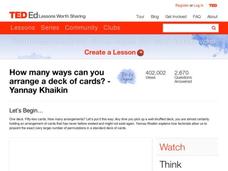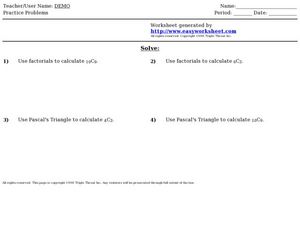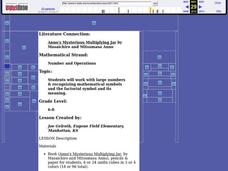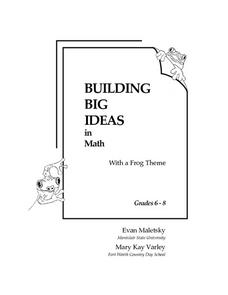Virginia Department of Education
Organizing Topic: Probability
The probability is high learning will occur! A well-designed unit introduces learners to the concepts of independent, dependent, and mutually exclusive events. Using Venn diagrams, the lessons ask learners to analyze many different...
TED-Ed
How Many Ways Can You Arrange a Deck of Cards?
Entertain and grab your learners' attention with a short video clip that engagingly teaches the concept of a permutation and how a factorial is a wonderful shortcut for theoretical probability calculations.
Curated OER
Factorial Notation
In this factorial notation activity, 9th graders solve 10 different problems that include writing out various equations in factorial notation form. First, they write out the factorials and cancel out what they can. Then, students solve...
Curated OER
Factorials
For this factorials worksheet, 11th graders solve 10 different equations that include various forms of factorials. They write out each of the factorials using enough of the factors to cancel out. Then, students cancel out all duplicate...
CK-12 Foundation
Combination Problems: Friends at a Party
Friend or stranger? Can there be less than three in a group? The interactive asks learners to prove that for seven people at a party, at least three of them are either mutual friends or mutual strangers. Pupils determine the number of...
Curated OER
Section 15-9: Permutations
In this permutations worksheet, high schoolers solve 16 multiple choice and short answer questions. Students find factorials and permutations of letters and numbers.
Curated OER
nCr: Combinations
In this probability instructional activity, learners utilize factorials or Pascal's Triangle to calculate the combination given in the form of nCr. There are 4 questions.
Curated OER
"Anno's Mysterious Multiplying Jar" by Masaichiro and Mitsumasa Anno
Students work with large numbers and recognizing mathematical symbols and the factorial symbol and its meaning.
Curated OER
Building Big Ideas in Math With a Frog Theme
In this problem solving worksheet about frogs, students complete two pages of activities. Students figure out how a frog can hop between lily pads following the rules given. Students draw all possible paths.
Curated OER
Mathematics Witing: Algebraic Processes and Its Connections to Geometry
Students, using manipulatives, determine how many different ways there are to arrange 3 and 4 objects. They organize and record their arrangements. Students investigate the pattern generated by 3 and 4 objects, they predict how many ways...
Curated OER
Students use fundamental counting principle to compute combinations and permutations
Learners define Pascal's triangle and special notations used to represent nth elements. In this geometry lesson plan, students solve problems using permutations and combinations. They compare the formula for permutation to that of...
Curated OER
Combinations
Young scholars investigate the possibility of different events using combination. In this statistics lesson, students investigate the accuracy of permutations and combinations. They solve problems related to combinations.
Shmoop University
Shmoop: Basic Statistics & Probability: Factorials
The probability resource investigates factorials. Students learn about the topic through notes and examples. The tutorial consists of practice exercises to check for comprehension of the concept.
Mathigon
Mathigon: Combinatorics: World of Math
This lesson focuses on Combinatorics, a branch of mathematics which is about counting. It includes 5 sections: Factorials, Permutations, Combinations, Combinatorics and Pascal's Triangle, and Combinatorics and Probability with examples...
Wolfram Research
Wolfram Math World: Topics of Permutation
This MathWorld site is a lite to link to a multitude of sites involving permutations. Look through to find your specific needs. If you are looking at this site with regards to a probability and statisics class you will probably want to...
Other
Lake Tahoe Com. College: Fundamental Counting Principle
Explains the fundamental principle of counting, which is the beginning point for any study of counting techniques such as combinations and permutations.

















